OUT-OF-DATE, LAST UPDATED: 2017
Overview
Monday, March 27th, through Friday, March 31st, has been designated as Severe Weather Awareness Week for the state of Nebraska. This week provides the National Weather Service with an opportunity to test communication systems and to get potentially lifesaving information to the public.
This page has been created in support of that week, raising severe weather awareness for the state of Nebraska. This page will also serve to provide severe weather information to all citizens across the High Plains. Spring is fast approaching...stay aware and please prepare!
Anytime the threat for severe weather exists, stay updated on the latest weather information by going to the National Weather Service Website, https://www.weather.gov, or by tuning in to NOAA Weather Radio All Hazards, or your local television and radio station. Make sure to watch for signs for approaching storms, such as darkening skies, increasing winds, flashes of lightning, and thunder.
Safety information can be found at: www.weather.gov/safety
To download the Nebraska Winter Weather Awareness Packet, click here!
Sunday:
Now is the time for everyone to review their safety plans and be prepared for the severe weather season.
Before severe weather strikes, develop a plan of action. Identify a place for you and your family to take shelter in the event of severe weather. Once you have a plan of action, conduct frequent drills to ensure everyone knows what to do at all times. Make sure you know what to do if you are at home, work, school, or outdoors, when severe weather strikes.
Each day during Severe Weather Awareness Week…the National Weather Service in Goodland will cover severe weather topics and have this information available on our webpage as well as on NOAA Weather Radio All Hazards.
Topics which will be covered include:
Severe Weather Terminology
Thunderstorms
Tornadoes
Lightning
Flooding
Anyone who needs information on severe storms in Nebraska should contact their nearest National Weather Service office. Here are the NWS offices that serve Nebraska from east to west:
Omaha/Valley:
Sioux Falls, South Dakota:
Hastings:
North Platte:
Goodland, Kansas:
Cheyenne, Wyoming:
Sunday's Social Media Posts
 |
 |
 |
Monday:
Though spring is already upon Nebraska, it is never too late to start preparing for severe weather season. Today is the first day of Severe Weather Awareness Week for the state of Nebraska, which will end Friday, March 31st. Severe Weather Awareness Week provides the National Weather Service with an opportunity to test communication systems and to get potentially lifesaving information out to the public. Now is the time for everyone to review their safety plans and prepare for the severe weather season.
The topic for today is Severe Weather Terminology.
It is important to understand the terms you may hear in a product issued by the National Weather Service.
A thunderstorm is considered severe when it produces hail one inch in diameter or larger, winds that are equal to or greater than 58 miles per hour, or a tornado.
A tornado is a violently rotating column of air which extends from a convective cloud and is in contact with the ground. The entire column of air associated with a tornado is not always visible, and may only be visible once it has picked up enough dirt and debris. A tornado can strike with little or no warning.
A flash flood is a rapid rise in water that occurs with little or no warning, and is usually the result of intense rainfall over a relatively small area in a short amount of time.
A watch (Tornado or Severe Thunderstorm) means that conditions are favorable for the development of severe weather in and close to the watch area. The size of the watch depends on the situation, and is usually issued for a duration of 4 to 8 hours. Be Prepared!
A warning (Tornado or Severe Thunderstorm) means that severe weather has either been detected by radar or reported by storm spotters. Information in the warning will include the location, the primary threat, and path of the storm. Warnings can be issued without a watch already in effect. People in the affected area should seek shelter immediately. Take Action!
Before severe weather strikes, develop a plan of action. Identify a place for you and your family to take shelter in the event of severe weather. Once you have a plan of action, conduct frequent drills to ensure everyone knows what to do at all times.
Additional information on terminology can be found at: http://www.nws.noaa.gov/om/thunderstorm/
Monday's Social Media Posts
 |
 |
 |
 |
Tuesday:
Today marks the second day of Severe Weather Awareness Week for the state of Nebraska, which continues through Friday, March 31st.
The topic for today is Severe Thunderstorms.
A thunderstorm is considered severe when it produces hail that is one inch in diameter or larger, damaging winds equal to or greater than 58 miles per hour, or a tornado.
There are numerous aspects of severe thunderstorms that pose a threat to life and property. Along with the threat of large hail, damaging winds, and tornadoes, everyone must also be aware of the possibility of dangerous lightning and flooding. Lightning, flooding, and tornadoes will be discussed later during the week.
Hail is produced in a thunderstorm as rising currents of air, known as updrafts, carry water droplets to a height where freezing occurs. Hail continues to grow inside of a thunderstorm until it becomes too heavy and can no longer be supported by the storm updraft. Once this occurs, the hailstone falls to the ground. Large hail is an indication that a thunderstorm is quite intense with a very strong updraft. The largest hailstone ever recorded in the United States fell in Vivian, South Dakota. This hailstone had a diameter of 7.9 inches, a circumference of over 18 inches and weighed 1.94 pounds.
Another significant severe weather threat is damaging winds, which can be caused by an event known as a downburst. A downburst is a small area of rapidly descending air beneath a thunderstorm. Once this descending air hits the ground, it spreads out in all directions. Downbursts and the resulting straight line winds can cause damage comparable to a tornado.
Additional information on severe thunderstorms, hail, and wind can be found at:
http://www.nws.noaa.gov/om/thunderstorm/
http://www.nws.noaa.gov/om/wind/
Tuesday's Social Media Posts
 |
 |
 |
 |
 |
Wednesday:
Today marks the third day of Severe Weather Awareness Week for the state of Nebraska, which continues through Friday, March 31st.
The topic for today is Tornadoes.
Know what to do before, during and after a tornado! It could save your life.
Before a tornado:
Pick a tornado safe room in your home, school or workplace. A basement, storm cellar, or an interior room on the lowest floor with no windows are your best options. Do not seek shelter in large rooms such as auditoriums or gymnasiums.
Make sure all members of your family know where to go and what to do. Put together a family communications plan.
Store emergency supplies such as a first aid kit and flashlight with extra batteries.
Don’t get caught in traffic during a storm! Have a plan well in advance.
During a tornado:
If a tornado warning is issued, or you see a tornado approaching, seek shelter immediately! Remember tornadoes can develop quickly.
If possible, get under something sturdy like a table or work bench. Stay away from windows and cover up with blankets or pillows to protect yourself from flying debris.
If you are outside, seek shelter inside a sturdy building.
Mobile homes are never safe during a tornado! Head for a storm shelter immediately.
If shelter is not nearby or you are in a mobile home, get into a vehicle and drive to the closest shelter. Community storm shelters, local businesses with a tornado shelter, or homes of friends, families, or neighbors that have sturdy shelter (tornado shelter, safe room, basement, interior room of a well-built house) are all better options than being caught outside or in a mobile home.
After a tornado:
If you are in an area that was damaged, be careful of debris that may include sharp and dangerous objects. Be aware there may be downed power lines and broken gas lines.
Use battery powered flashlights when examining buildings. Do not use candles which could start a fire.
If inside and you smell gas or hear a blowing or hissing noise, get everyone out of the building quickly and leave the door open. Call the gas company or fire department.
Use the telephone only for emergency calls so rescue operation lines are not tied up. Text your family and friends or use social media to let them know you are okay. Even if you are near an area that sustained tornado damage, stay off the phone so emergency calls and communications can get through.
If you were outside of the area damaged, stay away so you do not hamper rescue operations. Only return to those areas when local law enforcement gives the all clear.
Additional information on tornadoes can be found at: http://www.nws.noaa.gov/om/tornado/
Wednesday's Social Media Posts
 |
 |
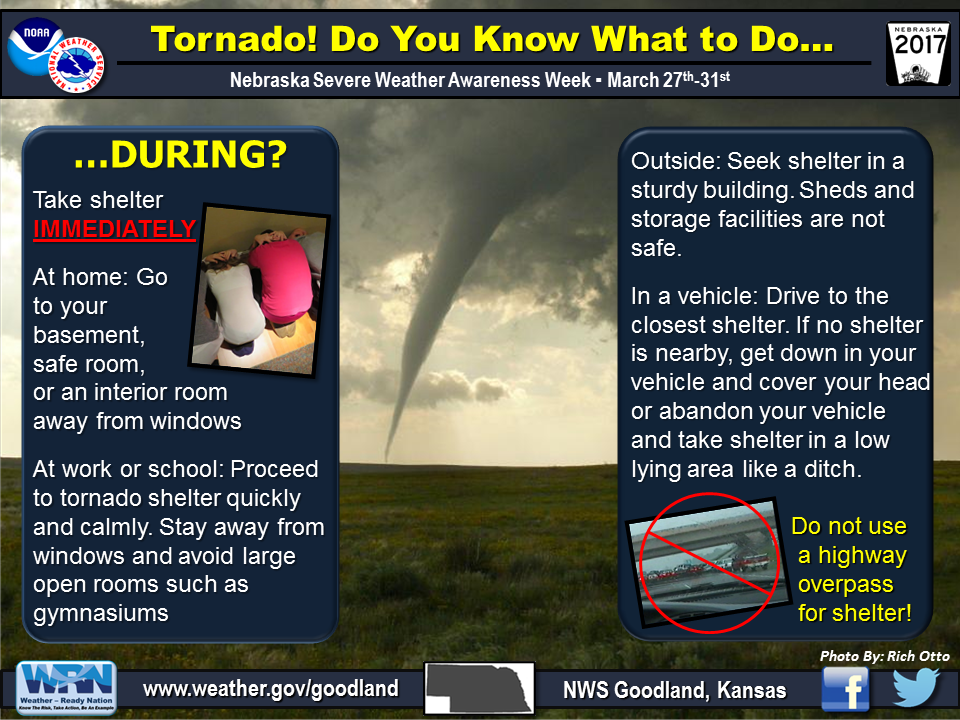 |
 |
 |
Thursday:
Today marks the fourth day of Severe Weather Awareness Week for the state of Nebraska, which continues through Friday, March 31st.
The topic for today is Lightning. When thunder roars, go indoors!
Lightning is one of the more dangerous aspects of thunderstorms, and is sometimes not taken as seriously as others. All thunderstorms contain lightning, and if you are close enough to hear thunder, you are close enough to be struck by lightning. Lightning strikes 10 to 15 miles away from a thunderstorm are possible, so seek shelter if a storm approaches. Summer is the peak season for lightning , but don’t be fooled, lightning strikes happen at all times of the year.
In the United States, an average (from 2006-2016) of 32 people are killed each year by lightning and hundreds more are severely injured. In 2016, 38 people died due to lightning strikes. People struck by lightning can suffer from a variety of long term, debilitating symptoms, including memory loss, sleep disorders, and numbness.
If you are outside and a thunderstorm threatens, get into a sturdy building or hard topped vehicle immediately. Once inside, do not stand near open doors, windows, or metal pipes. Do not use corded telephones or electrical appliances, do not take a shower, and do not do laundry or dishes, until the storm is over.
If you are outside and no building or vehicle is nearby, stay away from isolated trees or utility poles. Get off of tractors or other metal farm equipment. Get out of and away from open water. Stay away from wire fences, clotheslines, or other metal objects. Terminate any outdoor activities and seek shelter immediately.
Officials in charge of organized outdoor activities should put together a lightning safety plan before an event. Those involved in the event and their guardians should understand the plan and know what to do in case of an approaching thunderstorm.
If someone is struck by lightning, get medical help immediately. With proper treatment, including CPR if necessary, most lightning victims survive.
Additional information on lightning can be found at: https://www.lightningsafety.noaa.gov/
Thursday's Social Media Posts
 |
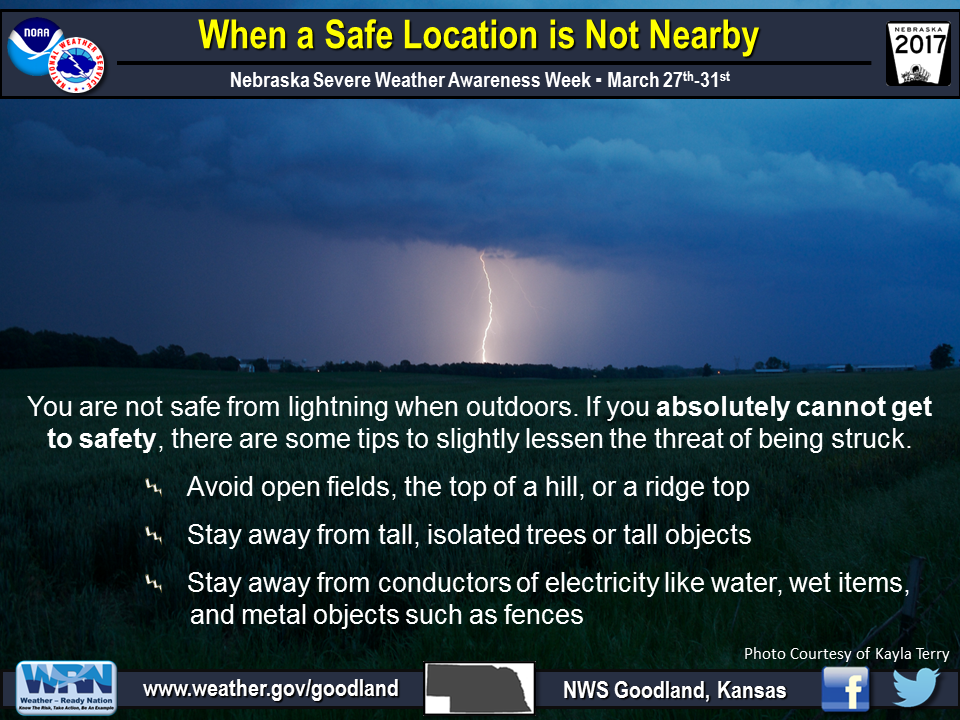 |
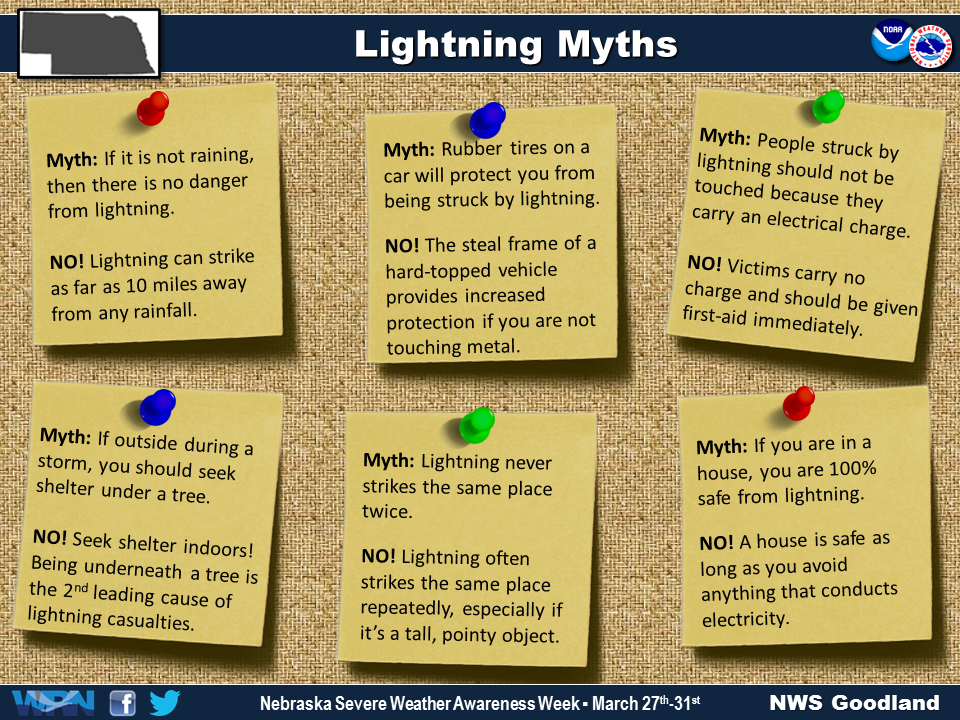 |
Friday:
Today marks the final day of Severe Weather Awareness Week for the state of Nebraska. We hope that you have found the information presented this week helpful in your preparation for the severe weather season.
The final topic for this week is Flooding. Turn Around, Don't Drown!
On average, more people are killed by flooding than by any other single severe weather hazard, including tornadoes, lightning, and hurricanes. Over half of all flood related drownings occur when a vehicle is driven into hazardous flood water. People underestimated the force and power of water.
Just 6 inches of fast moving water can knock over an adult. Twelve inches of water can float a small car, and if that water is moving, it can carry that car away. Most vehicles, including large SUVs, can be carried away by 18 to 24 inches of flowing water.
If a Flash Flood Warning is issued, or when flash flooding is imminent or occurring, act quickly to protect yourself and your family. Get out of areas that are subject to flooding and move to a safe area before access is cut off by flood waters. Low spots such as dips, canyons, and washes are not the places you want to be during flooding. If you are advised to evacuate, do so immediately and remember the following safety tips.
Do not drive if not necessary. If driving is necessary, do not drive over a flooded road or through flowing water. The depth of the water is not always obvious and the roadway may no longer be intact under the water. Never drive around a barricade, as they are placed there for your protection. If your vehicle stalls, leave it immediately and move to higher ground before water sweeps you and your vehicle away. If you approach a roadway that is flooded, Turn Around, Don’t Drown.
Never try to walk, swim, or play in flood water. You may not be able to determine if there are holes or submerged debris. You may not be able to determine how quickly the water is flowing, and you may be swept away. There is also a danger of hazardous materials polluting the water. Remember that water is an electrical conductor, and if there are power lines down, there is a possibility of electrocution. Be especially cautious at night when it is harder to recognize flood dangers.
Additional information on flooding can be found at: https://www.floodsafety.noaa.gov/
Friday's Social Media Posts
 |
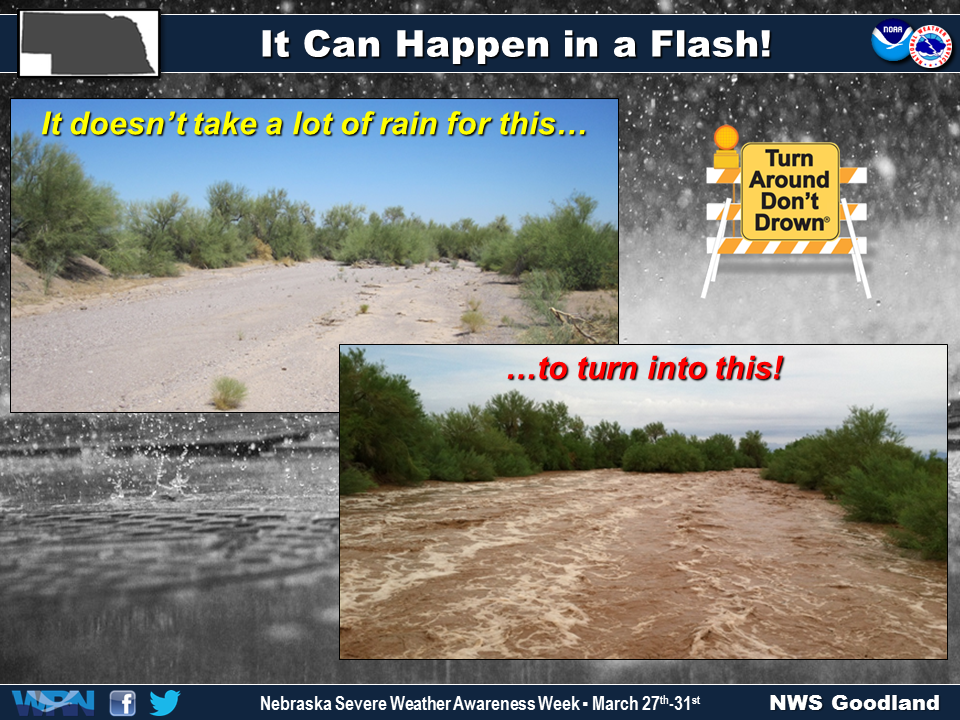 |
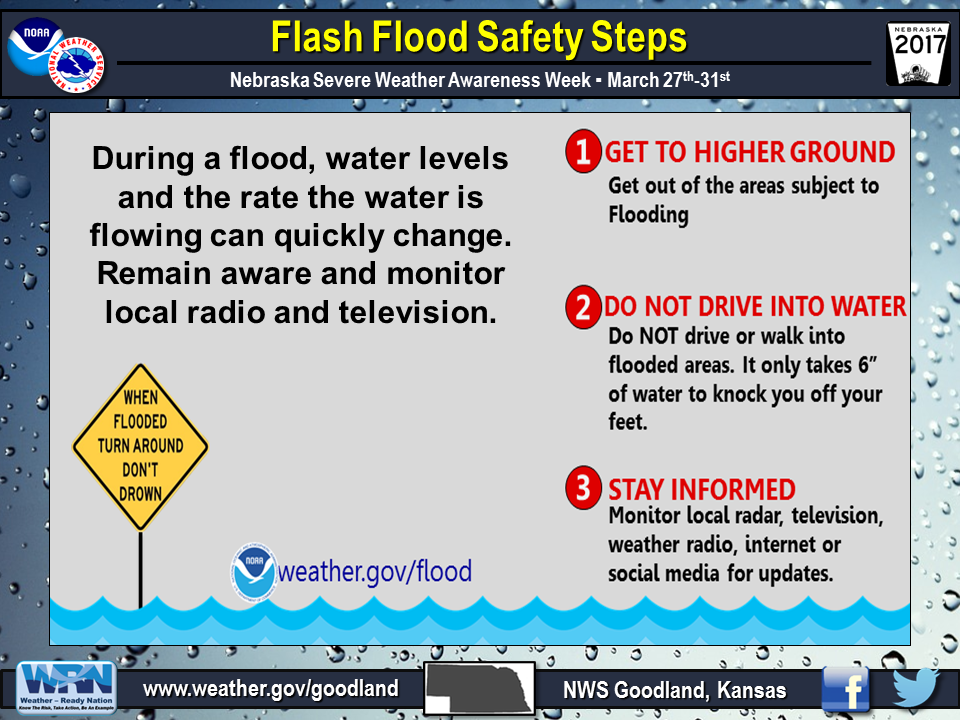 |
 |
Media use of NWS Web News Stories is encouraged! Please acknowledge the NWS as the source of any news information accessed from this site. |
 |